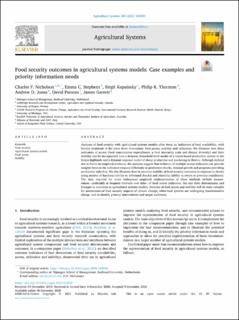| dc.contributor.author | Nicholson, Charles F. | |
| dc.contributor.author | Stephens, Emma C. | |
| dc.contributor.author | Kopainsky, Birgit | |
| dc.contributor.author | Thornton, Philip K. | |
| dc.contributor.author | Jones, Andrew D. | |
| dc.contributor.author | Parsons, David | |
| dc.contributor.author | Garrett, James | |
| dc.date.accessioned | 2021-09-28T06:55:49Z | |
| dc.date.available | 2021-09-28T06:55:49Z | |
| dc.date.created | 2021-05-10T15:04:36Z | |
| dc.date.issued | 2021 | |
| dc.identifier.issn | 0308-521X | |
| dc.identifier.uri | https://hdl.handle.net/11250/2783895 | |
| dc.description.abstract | Analyses of food security with agricultural systems models often focus on indicators of food availability, with limited treatment of the other three dimensions: food access, stability and utilization. We illustrate how three indicators of access (food consumption expenditures, a food insecurity scale and dietary diversity) and their stability can be incorporated into a dynamic household-level model of a maize-based production system in the Kenya highlands and a dynamic regional model of sheep production and marketing in Mexico. Although stylized due to limits on empirical evidence, the analyses suggest that inclusion of multiple access indicators can provide insights because the indicators respond differently to production shocks, demand growth and programs providing production subsidies. We also illustrate how to examine stability of food security outcomes in response to shocks using metrics of hardness (ability to withstand shocks) and elasticity (ability to return to previous conditions). The data required for more widespread empirical implementation of these methods include measurement—preferably at frequent intervals over time—of food access indicators, but also their determinants and linkages to outcomes in agricultural systems models. Analyses of food access and stability will be most valuable for assessments of food security impacts of climate change, when food systems are undergoing transformative change and to identify priority interventions and target audiences. | en_US |
| dc.language.iso | eng | en_US |
| dc.publisher | Elsevier | en_US |
| dc.rights | Navngivelse 4.0 Internasjonal | * |
| dc.rights.uri | http://creativecommons.org/licenses/by/4.0/deed.no | * |
| dc.title | Food security outcomes in agricultural systems models: Case examples and priority information needs | en_US |
| dc.type | Journal article | en_US |
| dc.type | Peer reviewed | en_US |
| dc.description.version | publishedVersion | en_US |
| dc.rights.holder | Copyright 2021 the authors | en_US |
| dc.source.articlenumber | 103030 | en_US |
| cristin.ispublished | true | |
| cristin.fulltext | original | |
| cristin.qualitycode | 2 | |
| dc.identifier.doi | 10.1016/j.agsy.2020.103030 | |
| dc.identifier.cristin | 1909241 | |
| dc.source.journal | Agricultural Systems | en_US |
| dc.identifier.citation | Agricultural Systems. 2021, 188, 103030. | en_US |
| dc.source.volume | 188 | en_US |

